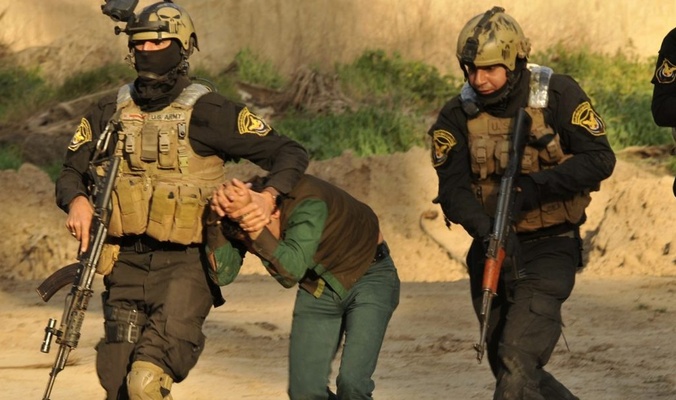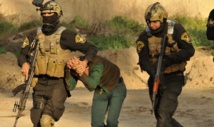Two weeks after troops and militia retook Tikrit, the main site of the "Speicher massacre" -- named after the military base near which the victims were seized -- is fast becoming a pilgrimage destination.
Every day, dozens of Iraqi fighters visit the narrow quay of the river police building, located inside the sprawling palace complex that now executed dictator Saddam Hussein built in his hometown.
Relatives, some of whom will never have a body to bury, have streamed to Tikrit from the south and other parts of the country to see the last place where their loved ones were alive.
Delegations of clerics, students and artists have also travelled to the site, which is still haunted by one of IS's worst atrocities but also symbolises and galvanises the commitment of those fighting against the jihadists.
"This is where the martyrs' blood was spilt, this should become a museum to all Iraqis, a symbol of pride," Sheikh Dargham al-Juburi said as he visited the site.
The black-clad and white-turbaned cleric, a representative of Iraq's top Shiite religious leader Grand Ayatollah Ali al-Sistani, wept and prayed over the small marble memorial.
He went on to draw parallels between the improvised Tikrit shrine and Karbala, the Shiite holy city south of Baghdad that was the scene of a 7th century battle considered a defining moment in the schism between Sunni and Shiite Muslims.
- Sacred place -
Speaking from the same spot a few days earlier, Moeen al-Kadhimi, a leader of the Badr Organisation -- both an important political party and one of Iraq's most powerful Shiite militias -- vowed to preserve the site.
"We will rehabilitate this area so that it becomes a symbol of the crime committed by those Dawaesh (IS members) and their allies... so that it remains a mark of shame on their faces forever," he said.
Kadhim Abdulhassan's cousin was one of the up to 1,700 recruits who were seized by IS in June 2014 when the group swept through almost a third of Iraq.
He says he received a call from him on his mobile as the group was being herded to the palace complex. The line cut and he never heard from his cousin again.
Abdulhassan is a member of the Ketaeb Jund al-Imam paramilitary group and his job is to keep watch over what is now being treated like a holy site.
Every day, he takes up his post on a balcony overlooking the marble epitaph decorated with bouquets of plastic flowers and candles.
Sitting on his iron garden chair with peeling white paint, his machinegun pointed across the Tigris, his thoughts wander between grief and revenge when he stares at the water that carried the dead downstream.
"I remember them and I spend some nights crying because it's a scene that hurts, something that is not easy," said the 30-year-old, a green ribbon knotted into the shoulder strap of his desert camouflage jacket.
Iraqi authorities have found more than 10 mass graves believed to contain the bodies of Speicher victims. Remains are still being exhumed and taken to Baghdad for identification.
IS released pictures and video footage of some of the executions last year.
Combined with a call by Sistani for Iraqis to take up arms against them, the June 2014 massacre played a key role in the mass recruitment of Shiite volunteers to fight the jihadists.
Abdulhassan said that more and more people come every day to pay their respects to the victims and he hoped the numbers would keep increasing.
"This place will be with me until I die... I hope to bring my family and kids to visit, because it is sacred."
-----------------------------------------------------------------------------------------------------------
Every day, dozens of Iraqi fighters visit the narrow quay of the river police building, located inside the sprawling palace complex that now executed dictator Saddam Hussein built in his hometown.
Relatives, some of whom will never have a body to bury, have streamed to Tikrit from the south and other parts of the country to see the last place where their loved ones were alive.
Delegations of clerics, students and artists have also travelled to the site, which is still haunted by one of IS's worst atrocities but also symbolises and galvanises the commitment of those fighting against the jihadists.
"This is where the martyrs' blood was spilt, this should become a museum to all Iraqis, a symbol of pride," Sheikh Dargham al-Juburi said as he visited the site.
The black-clad and white-turbaned cleric, a representative of Iraq's top Shiite religious leader Grand Ayatollah Ali al-Sistani, wept and prayed over the small marble memorial.
He went on to draw parallels between the improvised Tikrit shrine and Karbala, the Shiite holy city south of Baghdad that was the scene of a 7th century battle considered a defining moment in the schism between Sunni and Shiite Muslims.
- Sacred place -
Speaking from the same spot a few days earlier, Moeen al-Kadhimi, a leader of the Badr Organisation -- both an important political party and one of Iraq's most powerful Shiite militias -- vowed to preserve the site.
"We will rehabilitate this area so that it becomes a symbol of the crime committed by those Dawaesh (IS members) and their allies... so that it remains a mark of shame on their faces forever," he said.
Kadhim Abdulhassan's cousin was one of the up to 1,700 recruits who were seized by IS in June 2014 when the group swept through almost a third of Iraq.
He says he received a call from him on his mobile as the group was being herded to the palace complex. The line cut and he never heard from his cousin again.
Abdulhassan is a member of the Ketaeb Jund al-Imam paramilitary group and his job is to keep watch over what is now being treated like a holy site.
Every day, he takes up his post on a balcony overlooking the marble epitaph decorated with bouquets of plastic flowers and candles.
Sitting on his iron garden chair with peeling white paint, his machinegun pointed across the Tigris, his thoughts wander between grief and revenge when he stares at the water that carried the dead downstream.
"I remember them and I spend some nights crying because it's a scene that hurts, something that is not easy," said the 30-year-old, a green ribbon knotted into the shoulder strap of his desert camouflage jacket.
Iraqi authorities have found more than 10 mass graves believed to contain the bodies of Speicher victims. Remains are still being exhumed and taken to Baghdad for identification.
IS released pictures and video footage of some of the executions last year.
Combined with a call by Sistani for Iraqis to take up arms against them, the June 2014 massacre played a key role in the mass recruitment of Shiite volunteers to fight the jihadists.
Abdulhassan said that more and more people come every day to pay their respects to the victims and he hoped the numbers would keep increasing.
"This place will be with me until I die... I hope to bring my family and kids to visit, because it is sacred."
-----------------------------------------------------------------------------------------------------------









 Home
Home Politics
Politics











